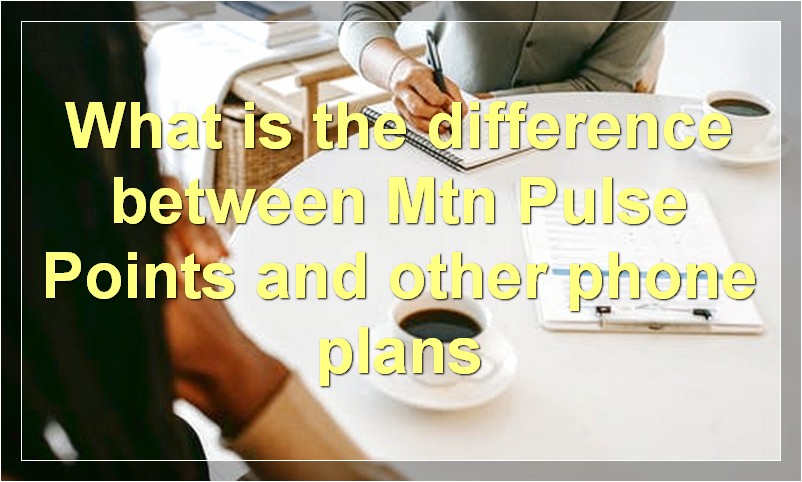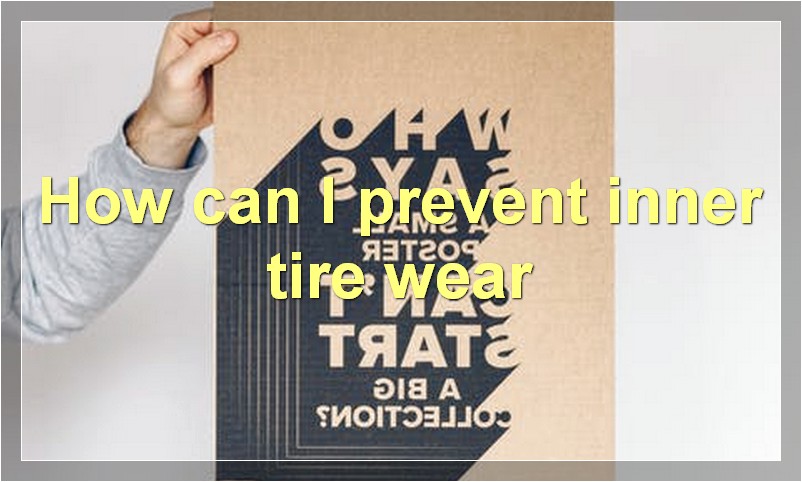If you’re noticing inner tire wear, it’s time to take action. Luckily, there are easy solutions to fix the problem.
How can I prevent inner tire wear?

Tire wear is a normal part of tire life. But, there are ways to help prevent it and keep your tires lasting longer. Here are four tips:
1. Check your tire pressure regularly
One of the easiest ways to help prevent inner tire wear is to check your tire pressure regularly. You can do this yourself with a tire pressure gauge, or you can have it done at most gas stations. Keeping your tires properly inflated can help improve your fuel economy and prevent premature wear.
2. Rotate your tires regularly
Another way to help prevent inner tire wear is to rotate your tires regularly. This means moving them from one position to another on your vehicle. For example, if you typically have your tires mounted on the front, you would move them to the back after a certain number of miles. This helps evenly distribute the weight and tread wear over all four tires.
3. Get regular alignments
If your tires are wearing unevenly, it could be due to an alignment issue. Getting regular alignments can help ensure that your tires are pointing in the right direction and wearing evenly. This can also help improve your fuel economy and prevent premature wear.
4. Avoid pot holes and other road hazards
One of the best ways to prevent inner tire wear is to avoid pot holes and other road hazards. This can be difficult, especially if you live in an area with a lot of construction or bad weather. But, if you can avoid hitting these things, it will help prolong the life of your tires.
What are the symptoms of inner tire wear?
Most people don’t know the symptoms of inner tire wear because it’s not something that is typically checked during routine maintenance. Here are four signs that your inner tires may be wearing down:
1. Your car is pulling to one side
If you notice that your car is veering to one side or the other, it could be a sign that your inner tires are worn down. This happens because the tread on the inside of the tire is thinner than the tread on the outside, so it can’t grip the road as well.
2. Your steering wheel is vibrating
Another symptom of inner tire wear is a vibrating steering wheel. This happens because the tread on the inside of the tire is uneven, so it doesn’t make contact with the road surface evenly. This causes a vibration that can be felt in the steering wheel.
3. Your car is shaking at high speeds
If you notice that your car is shaking when you’re driving at high speeds, it’s likely due to inner tire wear. The tread on the inside of the tire is thinner than the tread on the outside, so it can’t grip the road as well. This can cause your car to shake at high speeds.
4. You’re hearing a humming noise
If you start to hear a humming noise coming from your car, it could be due to inner tire wear. The tread on the inside of the tire is thinner than the tread on the outside, so it can’t grip the road as well. This can cause a humming noise as the tire spins.
How do I know if my tires need to be replaced?
It is important to regularly check your vehicle’s tires to ensure they are in good condition. There are a few ways to tell if your tires need to be replaced.
One way to tell if your tires need to be replaced is by the tread depth. You can measure the tread depth with a tire tread depth gauge. The minimum tread depth is 4/32 of an inch. If your tires have a tread depth of less than 4/32 of an inch, then they need to be replaced.
Another way to tell if your tires need to be replaced is by looking for signs of wear and tear. If you see any cracks, bald spots, or bulges, then your tires need to be replaced.
If you’re not sure if your tires need to be replaced, you can always take them to a mechanic or tire shop and they can inspect them for you.
How often should I have my tires rotated?
It is important to keep up with the maintenance of your vehicle to avoid any unnecessary breakdowns or accidents. One question many people have is – how often should I rotate my tires?
Tire rotation is the practice of moving the wheels and tires of a vehicle from one position to another, to ensure even tire wear. When done correctly, it can greatly extend the life of your tires.
There are a few different schools of thought on how often to rotate tires. The most common perspective is that you should do it every 5,000 miles (8,000 km). However, some experts believe that you can wait until you hit 7,500 or even 10,000 miles (16,000 km).
There are a few things that you need to take into account when making your decision. The first is the type of drivetrain your vehicle has. If you have a front-wheel drive car, then the front wheels will bear more of the weight than the back wheels. This means that they will tend to wear out faster. For this reason, most mechanics recommend rotating front-wheel drive cars more frequently – every 3,000 to 4,000 miles (5,000 to 6,500 km).
The second thing you need to consider is your driving habits. If you do a lot of stop-and-go driving or spend a lot of time in heavy traffic, your tires will wear down faster than someone who spends most of their time on the highway. In these cases, it’s probably a good idea to err on the side of caution and rotate your tires more frequently.
Finally, you need to take into account the type of tires you have. If you have high-performance tires, they will likely have a shorter lifespan than regular tires. For this reason, you may want to consider Rotating them more often.
In general, following the manufacturer’s recommendations is a good idea. They know your car better than anyone and they will usually err on the side of caution. If you can’t find any recommendations, then following the 5,000-mile rule is a good starting point.
What is the difference between inner and outer tire wear?

When it comes to your car, there are a lot of different parts that can wear down over time. This is especially true for your tires, which can experience inner and outer tire wear. While both types of tire wear can be problematic, they can also be caused by different things. Here’s a closer look at the difference between inner and outer tire wear:
Inner tire wear is typically caused by overinflation, which causes the center of the tire to contact the ground more than the edges. This can lead to a cupping effect, where the tread wears down in a circular pattern. Inner tire wear can also be caused by issues with your suspension, such as worn out shocks or struts.
Outer tire wear, on the other hand, is usually caused by underinflation. When your tires are underinflated, the entire tread area comes into contact with the ground. This causes the edges of the tire to wear down first, followed by the rest of the tread. Outer tire wear can also be caused by excessive speed and aggressive driving.
So, what’s the difference between inner and outer tire wear? Inner tire wear is typically caused by overinflation, while outer tire wear is usually caused by underinflation. Both types of tire wear can be problematic, but they often require different solutions. If you’re having trouble with either type of tire wear, it’s best to consult a professional mechanic to get to the root of the problem.
Should I be concerned about inner tire wear?
If you’re like most drivers, you probably don’t spend a lot of time thinking about your tires. But if you want to get the most out of your tires and avoid costly repairs down the road, it’s important to be aware of the different types of tire wear and what causes them.
One type of tire wear that you may not be familiar with is inner tire wear. Inner tire wear is when the tread on the inside edge of the tire wears away faster than the rest of the tread. This can happen for a number of reasons, but the most common cause is improper inflation.
If your tires are under-inflated, they will flex more as you drive, which causes the inner edges of the tread to wear away faster. Over-inflation can also cause inner tire wear, as well as other problems like uneven tread wear and decreased traction.
Another common cause of inner tire wear is misalignment. If your wheels are out of alignment, the tires will scrub against the road surface as you drive, which will cause the tread to wear away on the inside edges.
If you suspect that your tires are suffering from inner tire wear, it’s important to have them inspected by a professional as soon as possible. Inner tire wear can lead to a number of problems, including decreased fuel economy, decreased traction, and even blowouts.
So, should you be concerned about inner tire wear? Yes, if you want to avoid costly repairs and keep your car running smoothly, it’s important to be aware of the different types of tire wear and what causes them.
What are some common causes of inner tire wear?
Worn inner tires are a common issue among drivers. Many factors can contribute to this problem, including improper alignment, driving habits, and even the type of vehicle you drive.
One of the most common causes of worn inner tires is improper alignment. When your wheels are out of alignment, it puts extra stress on your tires, which can cause them to wear down prematurely. You may notice that your car pulls to one side when you’re driving, or that your steering wheel is off-center. If you suspect your car’s alignment is off, take it to a mechanic for a check-up.
Another common cause of worn inner tires is your driving habits. If you tend to accelerate and brake hard, or make a lot of sharp turns, you’re putting extra wear and tear on your tires. Over time, this can cause the tread on your inner tires to become thinner than the tread on your outer tires.
Finally, the type of vehicle you drive can also affect the wear on your inner tires. If you drive a rear-wheel drive car, for example, the weight of the engine is placed over the back wheels. This can cause those wheels to spin faster and work harder than the front wheels, leading to more wear on the inner treads.
If you’re noticing uneven wear on your inner tires, it’s important to take action to correct the problem. Otherwise, you could be at risk for a blowout or other serious issue.
How can I fix inner tire wear?
Tire wear is a common issue that many drivers face. There are a few different ways that you can fix inner tire wear, depending on the severity of the issue.
If you have a small amount of inner tire wear, you can try to adjust your driving habits. Avoid hard braking, accelerating too quickly, and making sharp turns. These all put stress on your tires and can cause inner tire wear. You should also check your tire pressure regularly and inflate your tires to the proper level. This will help reduce stress on your tires and improve their lifespan.
If you have more significant inner tire wear, you may need to have your alignment checked. Misaligned wheels can cause your tires to wear unevenly. You may also need to have your suspension checked if your vehicle is constantly bouncing or jarring while you drive. These issues can also lead to inner tire wear.
In some cases, inner tire wear may be caused by a problem with your wheel rim. If your wheel rim is bent or out of round, it can cause your tire to wear improperly. You’ll need to have your wheel rim repaired or replaced if this is the case.
If you’re not sure what is causing your inner tire wear, it’s best to take your vehicle to a professional mechanic for an inspection. They can help diagnose the problem and recommend the best course of action for fixing it.
Is it safe to drive with inner tire wear?
According to a recent study, nearly one in five American drivers have experienced a blowout due to inner tire wear.
While most of us are familiar with the dangers of driving on bald tires, inner tire wear is a less publicized but equally dangerous condition.
Inner tire wear occurs when the tread on the inside of the tire wears down faster than the tread on the outside. This can happen for a number of reasons, including incorrect tire inflation, camber misalignment, or simply driving habits.
If you suspect your tires may be suffering from inner wear, there are a few things you can do to check. First, take a look at the tread depth on the inside and outside of your tires. If the inside tread is noticeably shallower than the outside, it’s a good indication that you have inner tire wear.
Another way to check is to look at your tires’ sidewalls. If you see cracks or bulges on the inside of the sidewall, that’s another sign of inner tire wear.
If you do find evidence of inner tire wear, it’s important to take action immediately. Driving on worn tires is dangerous and can lead to a blowout. The best course of action is to replace your tires as soon as possible.
In the meantime, there are a few things you can do to minimize the risk of driving on worn tires. First, make sure your tires are properly inflated. Second, avoid sudden braking or acceleration, and take corners slowly. And finally, avoid driving in extreme weather conditions if at all possible.
By taking these precautions, you can help ensure your safety until you’re able to get new tires.




